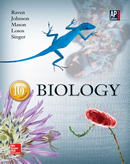1 A) DNA strands are less likely to spontaneously break because of the hydrogen bonds between bases. B) If DNA stored information for the synthesis of RNA, RNA could be freed up for enzymatic functions. C) Cells with both DNA and RNA would have an advantage over cells with just RNA, because DNA does not spontaneously break and RNA could carry out enzymatic functions. D) Reverse transcriptase could occur and DNA could make RNA. E) DNA could be used to make proteins directly. 2 A) decay time. B) decay product. C) half-life. D) half-decay. E) useful dating range. 3 A) Carbon dioxide (CO2 ) B) Nitrogen (N2 ) C) Hydrogen Sulfide (H2 SO4 ) D) Oxygen (O2 ) E) Water vapor (H2 O) 4 A) Serial endosymbiosis of first a heterotrophic bacterium, and then in algae, a subsequent acquisition of cyanobacteria. B) Endosymbiosis of an ancestral prokaryote which diverged to form these organelles in a host which eventually gave rise to eukaryotes. C) Uptake of DNA of eukaryotes from dead bacteria gave rise to new combinations, eventually forming these organelles through natural selection. D) Ancestors to plants picked up a cyanobacterium which gave rise to chloroplasts. Animal ancestors did the same to a heterotrophic bacterium to establish mitochondria. E) More than one of these answers is believed to be correct by most scientists. 5 A) layered rocklike structures formed by some cyanobacteria (blue-green algae). B) the earliest known arthropods. C) found only in rocks of Carboniferous age. D) the earliest known arthropods and found only in rocks of Carboniferous age are correct. E) fossilized coral reefs. 6 A) the fusion of two archean cells to form the eukaryote with the eukaryotic mitochondrion and chloroplast inside. B) the absorption of RNA from prokaryotic cells. C) prokaryotic cells being engulfed and becoming internal symbionts within an early eukaryotic cell. D) only the absorption of DNA from dead prokaryotic cells used as food. E) prokaryotic cells being engulfed and becoming external symbionts within an early bacteria cell. 7 A) True B) False 8 A) Genus B) Species C) Family D) Class E) Domain 9 A) geological activity. B) diversity of major animal groups. C) algal diversity. D) the number of days in the year. E) the amount of fish, of a single species, in the seas. 10 A) Permian Period. B) Tertiary Period. C) Devonian Period. D) Cretaceous Period. E) Jurassic Period. 11 A) Phanerozoic. B) Mesozoic. C) Cenozoic. D) Proterozoic. E) Precambrian. 12 A) 8 billion years. B) 4.5 billion years. C) 3.5 billion years. D) 1.5 billion years. E) a few thousand years. 13 A) ammonia and water B) amino acids C) CO2 and H2O D) formaldehyde and hydrogen sulfide E) methane and oxygen 14 A) sugars. B) DNA. C) phospholipids. D) RNA. E) steroids. 15 A) cyanobacteria. B) green photosynthetic bacteria. C) purple sulfur bacteria. D) non-sulfur purple bacteria. E) methane bacteria.





